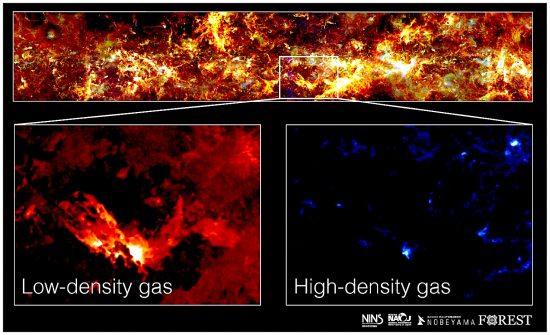
October 27, 2020
Stars are conventionally thought to form in regions of high density.
According to a recent press release from the Nobeyama Radio Observatory, astronomers detected “1000 times” fewer instances of “star birth” than their astrophysical models predict. Since common ideas about stars require them to form in regions where cold gas and dust are concentrated, the lack of those concentrations means there are fewer stars being formed in “distant galaxies”.
Stars are conventionally thought to begin their lives in the collapse of cold gas under gravitational influence. Stars are vortices of compressed matter heated to fusion temperatures by pressure, in that view. Clouds of gas and dust that are far less dense than a puff of smoke are consolidated by their slight attraction. Since the Interstellar Medium contains 10 atoms per cubic centimeter, on average, those clouds are scant, indeed. The clouds coalesce, irrespective of their vague structure, gradually coaxing more material into shape. Eventually, the protostar can no longer resist the inward gravitational attraction and it initiates a self-sustaining reaction.
There is a catch, however. The gas and dust must be extremely cold, otherwise thermal radiation generated by the friction of collapse would cause the cloud to dissipate instead of squeeze down into a star. How the cold is supposed to prevent the “star stuff” from heating up is not explained. If something is cold, but then it is crushed into a tiny volume, its temperature will rise regardless of its initial state. Many astronomers admit that their theories are lacking, but they are the best they have.
Some of the open questions regarding star formation are illustrative of the problems: How do massive stars form? Can outward radiation stop accretion? What drives star cluster formation? Where do molecular clouds come from? Are molecules necessary? What is the role of turbulence in star formation? What causes star formation on the galactic scale?
As stated many times in previous Picture of the Day articles, the Electric Star theory provides solutions to the puzzles and confusion so often expressed in science journals. A fundamental aspect of the Universe is that it is composed almost entirely of plasma. Plasma is an electrically charged state of matter, so it responds to electrodynamic forces, along with gravity. Those wisps of gas and dust, so cherished by astronomers, are not electrically neutral.
Charged particles in motion constitute an electric current that forms plasma filaments in nebulae. Electric currents are accompanied by magnetic fields that wrap around the filaments, diminishing in a 1/√r relationship. That means that plasma filaments are probably the most powerful long-range attractors in the Universe, drawing charged matter toward them, incidentally dragging the neutral molecules along for the ride.
Along the strands of electromagnetically confined plasma, Bennett pinches occur, crushing plasma into tightly confined spaces. As the filaments become more narrow, the magnetic fields increase, compressing the plasma ever more tightly. Eventually, the pinch effect causes plasmoids to form along the filament. Thus, stars are born from an electrical parentage.
Stephen Smith
The Thunderbolts Picture of the Day is generously supported by the Mainwaring Archive Foundation.












